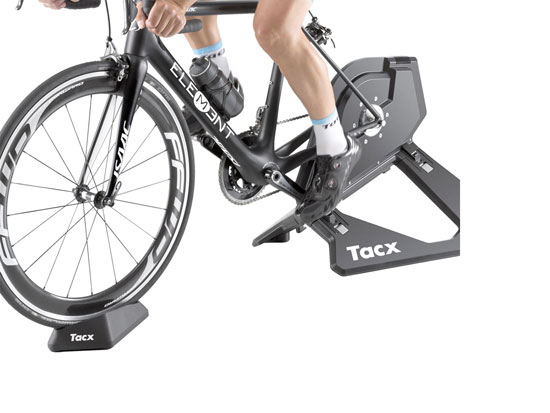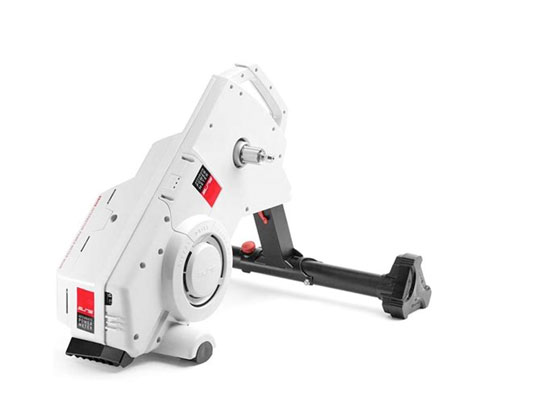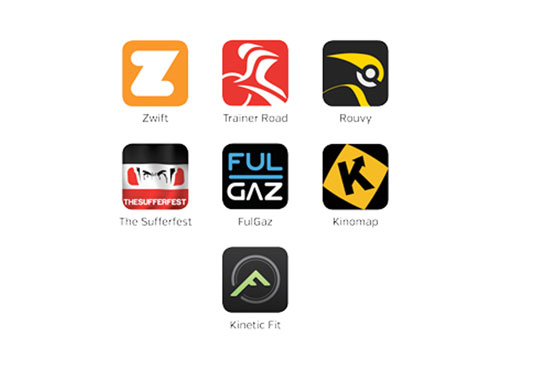Direct Drive Trainer
A Direct Drive trainer is a type of indoor bike trainer that provides a realistic and immersive cycling experience.
Unlike other trainers that require you to attach your bike’s rear wheel to a roller, Direct Drive trainers allow you to remove the rear wheel and directly connect the bike’s frame to the trainer.
The main component of a Direct Drive trainer is a large flywheel, which replaces the rear wheel of the bike. The bike is securely attached to the trainer by removing the rear wheel and mounting the rear dropouts onto the trainer’s cassette.
It’s important to note that Direct Drive trainers require a compatible cassette that matches your bike’s drivetrain. Some trainers come with a cassette included, while others require you to purchase one separately.
Direct Drive trainers are a popular choice among cyclists looking for a high-quality, immersive, and accurate indoor training experience. While they tend to be more expensive than other trainers, their performance and functionality make them a worthwhile investment for serious riders and athletes.
Is a Direct Drive Trainer a Smart Indoor Bike Trainer?
While a Direct Drive trainer can be a smart bike trainer, not all smart trainers are Direct Drive trainers.
Smart trainers refer to trainers that have integrated technology to connect with external devices and applications for enhanced training and data analysis.
While not all Direct Drive trainers are smart trainers, many models in the market offer smart features.
Smart Direct Drive trainers have built-in sensors and connectivity options such as Bluetooth or ANT+ that allow them to communicate with various devices like smartphones, tablets, or cycling computers. This connectivity enables them to interact with virtual training platforms, training apps, and performance analysis software.
With a smart Direct Drive trainer, you can access a range of features and benefits. These trainers can provide real-time data feedback such as speed, power output, cadence, and distance, allowing you to monitor and track your performance during indoor training sessions. They often integrate with popular training apps and platforms that offer interactive virtual rides, structured workouts, and training plans.
Smart Direct Drive trainers can also simulate different terrains and gradients based on the virtual training environment or the training app you are using. This means that when you’re riding in a virtual world or following a structured workout, the trainer will automatically adjust resistance to mimic the virtual terrain, making your indoor riding experience more immersive and challenging.
Additionally, smart trainers often allow for wireless firmware updates, ensuring that you have access to the latest features and improvements as they become available. Some models even offer features like ERG mode, which automatically adjusts resistance to maintain a specific power output, making it easier to follow structured workouts or interval training sessions.
While all smart trainers offer connectivity and advanced features, not all smart trainers are Direct Drive trainers.
There are other types of smart trainers available, such as wheel-on smart trainers, which utilize a roller and require you to mount your bike with its rear wheel onto the trainer.
What Are the Different Types of Direct Drive Trainers?
There are several different types of Direct Drive trainers available in the market, each offering its own features and characteristics.
Here are the main types of Direct Drive trainers:
Standard Direct Drive Trainers
These trainers are designed to directly replace the rear wheel of your bike. They typically feature a cassette mounted directly on the trainer, allowing you to remove your bike’s rear wheel and attach the bike frame directly to the trainer. This type of Direct Drive trainer provides a stable and secure connection for an immersive indoor cycling experience.
Wheel-off Direct Drive Trainers
These trainers require you to remove your bike’s rear wheel before attaching the bike frame to the trainer. Instead of mounting a cassette directly on the trainer, they use a belt or direct-drive system to transfer power from the bike’s drivetrain to the resistance unit. Wheel-off Direct Drive trainers often offer easy bike installation and provide a quiet and smooth riding experience.
Direct Drive Smart Trainers
These trainers combine the benefits of Direct Drive design with smart features. They have built-in sensors and connectivity options (such as Bluetooth or ANT+) that allow them to communicate with external devices and training apps. Direct Drive Smart trainers offer interactive training experiences, virtual rides, and data analysis, making them popular among cyclists looking for advanced training options.
Direct Drive Power Meter Trainers
These trainers not only provide a direct connection between the bike frame and the trainer but also incorporate a power meter into the resistance unit. This means that in addition to the smart features, they can measure and display accurate power output during your training sessions. Direct Drive Power Meter trainers are ideal for cyclists who want precise power data for training or performance analysis.
Direct Drive Interactive Trainers
These trainers take the smart experience to the next level by providing immersive and interactive features. They can simulate realistic road feel by adjusting resistance based on virtual terrain, allowing you to experience the ups and downs of virtual rides.
Direct Drive Interactive trainers often come with software or apps that offer a wide range of training programs, virtual routes, and multiplayer options for a more engaging indoor cycling experience.
It’s important to note that the specific features and capabilities may vary between different brands and models of Direct Drive trainers. When choosing a Direct Drive trainer, consider factors such as compatibility with your bike, power accuracy, noise levels, connectivity options, and the availability of compatible training apps or software.
Quick Overview of Pros & Cons of the Direct Drive Bike Trainer
| PROS Of The Direct Drive Trainer | CONS Of The Direct Drive Trainer |
|---|---|
|
|
The Case FOR a Direct Drive Bike Trainer (Pros)
Enhanced Performance and Realistic Feel
Direct Drive trainers offer a number of advantages for cyclists looking to elevate their indoor training experience. With a direct connection to the bike’s drivetrain, these trainers provide a more realistic and immersive riding feel compared to other types of trainers. The absence of the rear wheel eliminates any potential tire slippage and ensures direct power transfer, resulting in a more efficient and accurate representation of outdoor riding conditions.
Increased Stability and Durability
Direct Drive trainers are known for their sturdy construction and stable design. By removing the rear wheel and attaching the bike directly to the trainer, they offer improved stability during intense workouts and high-power efforts. This enhanced stability allows cyclists to confidently push their limits without worrying about balance or potential wobbling.
Quieter Operation
The absence of a spinning rear wheel significantly reduces noise levels when using a Direct Drive trainer. The direct connection between the trainer and the bike’s drivetrain results in a quieter and more enjoyable indoor training experience. This is particularly advantageous for those living in shared spaces or apartments where noise reduction is a consideration.
Accurate Power Measurement
Direct Drive trainers often incorporate advanced power measurement technology, such as strain gauges or power meters, which provide highly accurate and reliable power readings. This allows cyclists to track their power output during workouts, monitor progress, and effectively structure their training based on specific power targets.
Wide Compatibility and Connectivity
Most Direct Drive trainers support multiple connectivity options, including Bluetooth and ANT+, making them compatible with a wide range of devices and training apps. This enables cyclists to seamlessly connect their trainers to smartphones, tablets, cycling computers, and virtual training platforms, unlocking a wealth of training options and interactive features.
Convenience and Ease of Use
Direct Drive trainers typically feature a quick-release system or thru-axle compatibility, allowing for easy and hassle-free bike installation. The absence of the rear wheel simplifies setup and eliminates the need for wheel-on trainers’ tire adjustments. This makes it more convenient to transition between indoor and outdoor riding, especially for cyclists who frequently switch between training environments.
Optimal Power Output
Direct Drive trainers allow cyclists to generate maximum power without any energy loss due to wheel slippage. This makes them ideal for intense interval training sessions, sprint efforts, and high-power workouts where precise power output is crucial.
Improved Pedaling Dynamics
The direct connection between the trainer and the bike’s drivetrain ensures a smooth and consistent pedaling experience. Cyclists can maintain their natural pedaling technique without any disruptions, leading to better muscle activation and overall pedaling efficiency.
Longer Lifespan for Tires
With Direct Drive trainers, there is no tire contact with the trainer, resulting in reduced wear and tear on your bike tires. This not only saves you from having to frequently replace worn-out tires but also extends the lifespan of your tires, especially if you primarily use them for outdoor riding.
Easier Maintenance
Direct Drive trainers typically require less maintenance compared to wheel-on trainers. Since there is no direct contact with the rear wheel, issues related to tire pressure, tire wear, and wheel alignment are eliminated, simplifying the maintenance process.
Greater Compatibility with Disc Brake Bikes
Direct Drive trainers are often designed to accommodate bikes with disc brakes, making them suitable for cyclists who own bikes equipped with this braking system. They provide ample clearance for the disc rotor, ensuring compatibility and ease of use.
Enhanced Immersive Features
Many Direct Drive trainers offer additional features to enhance the immersive training experience. These may include integrated incline simulation, vibration feedback, and interactive resistance adjustments based on virtual terrains, creating a more engaging and realistic ride feel.
The Case AGAINST a Direct Drive Bike Trainer (Cons)
Here are some cons to consider when it comes to Direct Drive trainers:
Higher Cost
Direct Drive trainers generally have a higher price point compared to wheel-on trainers. The advanced technology, construction, and features of Direct Drive trainers contribute to their higher cost. This can be a deterrent for budget-conscious cyclists or those who are just starting with indoor training.
More Space and Storage Requirements
Direct Drive trainers typically have a larger footprint and require more space for setup compared to wheel-on trainers. The removal of the rear wheel and the need for a dedicated space for the trainer and bike can be a challenge for cyclists with limited space at home or in their training area.
Additional Bike Setup
Using a Direct Drive trainer involves removing the rear wheel and attaching the bike directly to the trainer. This setup process can be more time-consuming and require more effort compared to wheel-on trainers, which simply require placing the bike onto the trainer.
Less Portability
Due to their larger size and integrated design, Direct Drive trainers are generally less portable than wheel-on trainers. Moving them from one location to another or traveling with them may require disassembling or packing them carefully. This can be a limitation for cyclists who frequently travel or prefer a trainer that can be easily transported.
Compatibility Limitations
Direct Drive trainers may have compatibility limitations with certain bikes, especially those with unique frame designs, hub spacing, or axle standards. It’s important to ensure that your bike is compatible with the specific Direct Drive trainer you intend to purchase.
Less Flexibility for Quick Workouts
Since Direct Drive trainers require removing the rear wheel and attaching the bike, they may not be the most suitable option for quick, spontaneous workouts. If you prefer the convenience of easily hopping on and off the trainer for short sessions, a wheel-on trainer might be a more practical choice.
Do Smart Direct Drive Trainers Use ANT+ and Bluetooth ?
ANT+ and Bluetooth are two common wireless communication protocols used in Smart Direct Drive bike trainers.
ANT+
ANT+ Smart Direct Drive trainers are often preferred by professional athletes and serious cyclists due to their robust and reliable connectivity with ANT+ compatible devices.
They can connect to cycling computers, heart rate monitors, power meters, and cadence sensors that support the ANT+ protocol. The simultaneous transmission of data from multiple sensors ensures accurate and comprehensive workout metrics.
Bluetooth Smart Direct Drive Trainers
On the other hand, Bluetooth Smart Direct Drive trainers offer seamless connectivity with popular fitness and cycling apps that support Bluetooth.
They can transmit data such as speed, distance, power, and cadence to your connected smartphones, tablets, or other Bluetooth-enabled devices for tracking and analysis.
Both ANT+ and Bluetooth connectivity options provide different benefits and compatibility with various devices and software, allowing cyclists to choose the option that best suits their needs and preferences.
By leveraging this connectivity, Smart Direct Drive trainers can interact with virtual training platforms, such as Zwift, TrainerRoad, or Sufferfest, which offer immersive virtual cycling experiences.
Cyclists can join virtual group rides, compete in races, or follow structured training programs, all while their smart trainer adjusts the resistance in real-time based on the virtual terrain.
Additionally, Smart Direct Drive trainers can connect to training apps and performance analysis software, providing valuable insights into workout data, tracking progress over time, and offering personalized training plans.
This connectivity allows cyclists to analyze metrics like power output, cadence, speed, and heart rate, empowering them to optimize their training, set goals, and monitor their performance.
The ability to connect with a wide range of devices and software platforms makes smart trainers versatile and adaptable to individual preferences and training needs. They offer a dynamic and interactive training experience, enhancing the effectiveness and enjoyment of indoor cycling sessions.
Buying Guide for Direct Drive Trainers
What You Should Consider Before Buying
Connectivity
Consider the connectivity options provided by the Direct Drive trainer. Look for trainers that offer Bluetooth and ANT+ compatibility, as this will allow you to connect with a wide range of devices such as smartphones, tablets, cycling computers, and popular training apps or platforms.
Compatibility with Your Bicycle
Check the compatibility of the Direct Drive trainer with your bicycle. Ensure that it supports the type of bike you own, including the axle standards and cassette compatibility. Some trainers may require additional adapters or cassettes to fit your specific bike setup.
Compatibility with Training Apps
Verify that the direct drive bike trainer is compatible with popular training apps such as Zwift, TrainerRoad, or Peloton if you plan to use them. This ensures a seamless integration and access to various training programs, virtual routes, and interactive features.
Power Accuracy
Check the power accuracy specifications of the trainer. Higher accuracy ensures that your power readings are more reliable and consistent, allowing for better training analysis and tracking progress over time.
Connectivity
Consider the connectivity options of the trainer. Look for trainers that offer Bluetooth and ANT+ compatibility, as these allow you to connect to various devices and training apps for data tracking and analysis.
Resistance Levels
Evaluate the range of resistance levels offered by the Direct Drive trainer. Having a wide range of resistance options allows for a more versatile and challenging training experience, suitable for different fitness levels and workout goals.
Noise Level
Direct Drive trainers are generally quieter compared to wheel-on trainers, but there can still be variations in noise levels among different models. Consider the noise level if you live in an apartment or have noise-sensitive neighbors.
Stability and Durability
Look for a Direct Drive trainer with a sturdy and durable construction that can withstand intense workouts and provide stability during sprints or high-intensity efforts.
Software Compatibility
Check if the trainer is compatible with popular training software and virtual cycling platforms. This allows you to access a variety of training programs, virtual routes, and interactive features to enhance your indoor cycling experience.
Price and Value
Consider your budget and the overall value offered by the Direct Drive trainer. Compare features, performance, and customer reviews to determine if the trainer provides a good balance of quality and affordability.
Flywheel Weight
The weight of the flywheel can affect the feel of the ride. Heavier flywheels generally provide a smoother and more realistic cycling experience, as they mimic the inertia and momentum of outdoor riding.
Simulated Gradient
Some Direct Drive trainers have the ability to simulate gradients or inclines, allowing you to experience the feeling of climbing hills during your indoor workouts. Consider if this feature is important to you and if the trainer offers a wide range of simulated gradients.
Portability and Storage
If you have limited space or need to transport the trainer frequently, consider the portability and storage features. Look for trainers that are foldable, lightweight, or easy to disassemble for convenient storage and transportation.
Warranty and Customer Support
Check the warranty period and customer support provided by the manufacturer. A longer warranty can give you peace of mind and protect your investment. Additionally, reliable customer support can be beneficial if you have any questions or issues with the trainer.
User Reviews and Ratings
Take the time to read user reviews and ratings of the Direct Drive trainer you are considering. Pay attention to feedback on performance, ease of use, durability, and overall customer satisfaction. This can provide valuable insights from other cyclists who have firsthand experience with the trainer.
Pedaling Realism
Look for a Direct Drive trainer that provides a realistic pedaling feel. Factors such as smoothness, responsiveness, and the ability to simulate different riding conditions can enhance the overall cycling experience.
Build Quality and Durability
Ensure that the trainer is built with high-quality materials and has a sturdy construction that can withstand intense workouts. A durable trainer will not only last longer but also provide a stable and reliable platform for your training sessions.
User-Friendly Interface
Consider the user interface of the trainer, including the control panel or app interface. A clear and intuitive interface makes it easier to navigate through settings, adjust resistance levels, and access training programs or virtual cycling platforms.
Remember, everyone’s needs and preferences may vary, so it’s important to prioritize the factors that matter most to you when selecting a Direct Drive trainer.
Taking the time to research and evaluate these considerations will help you find the right trainer that aligns with your goals and delivers a rewarding indoor cycling experience.
What Are The Different Types of Direct Drive Trainers and What are Their Features?
The Different Direct Drive Trainers Are…
Standard Direct Drive Trainers:
These trainers replace the rear wheel of your bike and feature a cassette directly mounted on the trainer. Your bike’s rear wheel is removed, and the bike frame is attached directly to the trainer. This provides a stable and secure connection for an immersive indoor cycling experience.
Wheel-off Direct Drive Trainers:
These trainers also require the removal of your bike’s rear wheel, but instead of a cassette, they use a belt or direct-drive system to transfer power from the bike’s drivetrain to the resistance unit. Wheel-off Direct Drive trainers offer easy bike installation and provide a quiet and smooth riding experience.
Direct Drive Smart Trainers:
These trainers combine the benefits of Direct Drive design with smart features. They have built-in sensors and connectivity options like Bluetooth or ANT+ to communicate with external devices and training apps. Direct Drive Smart trainers offer interactive training experiences, virtual rides, and data analysis.
Direct Drive Power Meter Trainers:
These trainers incorporate a power meter into the resistance unit, in addition to the smart features. They provide accurate power measurement during your training sessions, making them ideal for cyclists who want precise power data for training or performance analysis.
Direct Drive Interactive Trainers:
These trainers offer immersive and interactive features, simulating realistic road feel by adjusting resistance based on virtual terrain. They come with software or apps that offer training programs, virtual routes, and multiplayer options for a more engaging indoor cycling experience.
So What’s the Difference Between a Standard Direct Drive Trainer & a Wheel-Off Direct Drive Trainer ?
The main difference between a standard Direct Drive trainer and a wheel-off Direct Drive trainer lies in the way they interact with the bicycle.
A Standard Direct Drive Trainer requires the user to remove the rear wheel of the bicycle and directly attach the bike frame to the trainer. This means that the trainer replaces the rear wheel entirely, and the bicycle is fixed in place by connecting the dropouts or through an axle mechanism.
On the other hand, a Wheel-off Direct Drive trainer also requires the removal of the rear wheel, but instead of physically connecting the bike frame to the trainer, it uses a cassette or freehub mechanism that the bike chain engages with. The bike’s drivetrain directly interacts with the trainer, and the rear wheel is not used during the training session.
The key advantage of a wheel-off Direct Drive trainer is that it eliminates the need to continuously mount and dismount the bike onto the trainer. It provides a more stable and secure connection, resulting in a more realistic cycling experience. Additionally, wheel-off trainers often offer more accurate power measurement and greater compatibility with different bike types and sizes.
On the other hand, a standard Direct Drive trainer may be simpler to set up and requires less adjustment to fit different bikes. It can also be a more cost-effective option compared to wheel-off trainers.
Standard Direct Drive Trainer: Features
A Standard Direct Drive trainer is a type of indoor bike trainer that allows you to remove the rear wheel of your bicycle and directly connect the bike frame to the trainer. It offers a more realistic and immersive cycling experience compared to traditional wheel-on trainers.
Here are some key features of Standard Direct Drive trainers:
Direct Power Transfer
With a Standard Direct Drive trainer, your bike’s drivetrain is directly connected to the trainer’s resistance unit. This results in a more efficient power transfer, as there is no loss of energy through the rear wheel.
Higher Power Accuracy
Direct Drive trainers typically offer higher power accuracy readings compared to wheel-on trainers. This is because the power measurement is taken at the drivetrain rather than relying on estimates based on wheel speed.
Realistic Road Feel
Direct Drive trainers are designed to simulate the feeling of riding on the road. They often incorporate features like large flywheels and advanced resistance systems to provide a smooth and realistic cycling experience, including replicating the inertia and resistance changes encountered during outdoor rides.
Quiet Operation
Standard Direct Drive trainers tend to operate quietly due to the absence of a rear wheel and the direct power transfer. This makes them suitable for indoor training without causing excessive noise disturbances.
Wide Resistance Range
Direct Drive trainers typically offer a wide range of resistance levels, allowing you to adjust the intensity of your workouts. This enables you to simulate various riding conditions, including steep climbs and fast descents.
Compatibility
Most Standard Direct Drive trainers are compatible with a wide range of bicycles, including road bikes and mountain bikes. They often come with different adapters and cassette options to accommodate different bike setups.
Connectivity Options
Many Standard Direct Drive trainers feature built-in connectivity options such as Bluetooth or ANT+, allowing you to connect them to various devices and training apps. This enables you to track your performance data, participate in virtual training programs, and analyze your workouts.
Stability and Durability
Direct Drive trainers are known for their stability and durability. They typically have a solid frame construction and wide bases to ensure stability during intense workouts. The absence of a rear wheel also eliminates the risk of tire wear or damage.
Popular Manufacturers
- Wahoo Fitness
- Tacx
- Elite
- Saris
- CycleOps
- Kinetic
- Bkool
- Garmin
Wheel-Off Direct Drive Trainer: Features
A Wheel-Off Direct Drive trainer, also known as a wheel-off smart trainer, is a type of indoor bike trainer that requires you to remove the rear wheel of your bicycle and directly connect the bike frame to the trainer.
Here are some key features of Wheel-Off Direct Drive trainers:
Direct Power Measurement
Wheel-off trainers provide accurate power measurement by directly measuring the forces applied to the drivetrain. This results in precise power readings that can be used for training analysis and tracking progress.
Realistic Cycling Experience
Wheel-off trainers are designed to simulate the feeling of riding on the road. They often feature large flywheels and advanced resistance systems to provide a smooth and realistic cycling experience, including replicating the inertia and resistance changes encountered during outdoor rides.
Quiet and Smooth Operation
Wheel-off trainers operate quietly and smoothly due to the absence of the rear wheel. This allows for a more enjoyable and distraction-free indoor training experience.
Easy Bike Compatibility
Most wheel-off Direct Drive trainers come with a range of adapters and cassette options to accommodate various bike types and sizes. This makes them suitable for a wide range of bicycles, including road bikes, mountain bikes, and gravel bikes.
Smart Connectivity
Wheel-off trainers are often equipped with smart connectivity features such as Bluetooth and ANT+, allowing you to connect to various devices and training apps. This enables you to track your performance data, participate in virtual training programs, and analyze your workouts.
Stability and Durability
Wheel-off trainers are known for their stability and durability. They typically have a sturdy frame construction and wide bases to ensure stability during intense workouts. The direct connection to the bike frame provides a secure and reliable training platform.
Resistance Control
Wheel-off trainers offer precise resistance control, allowing you to adjust the intensity of your workouts. Many models have programmable resistance levels and can simulate different terrains, such as steep climbs or fast descents.
Easy Setup and Maintenance
Wheel-off trainers are relatively easy to set up and require minimal maintenance. Once you have installed the trainer and connected your bike, you can quickly start your training session without the need for frequent adjustments or calibrations.
Popular Manufacturers
- Wahoo Fitness
- Tacx
- Elite
- Saris
- CycleOps
- Kinetic
- Bkool
- Garmin
So What’s the Difference Between a Direct Drive Smart Trainer,
A Direct Drive Power Meter Trainer & an Interactive Direct Drive Trainer ?
The main difference between a Direct Drive Smart Trainer, a Direct Drive Power Meter Trainer, and an Interactive Direct Drive Trainer lies in their specific functionalities and features:
Direct Drive Smart Trainer:
- These trainers combine the benefits of Direct Drive design with smart features.
- They have built-in sensors and connectivity options (such as Bluetooth or ANT+) that allow them to communicate with external devices and training apps.
- Direct Drive Smart trainers offer interactive training experiences, virtual rides, and data analysis, making them popular among cyclists looking for advanced training options.
- They can adjust resistance based on virtual terrain, provide real-time performance metrics, and offer compatibility with various training apps and software platforms.
- The emphasis is on connectivity, app integration, and interactive training experiences.
Direct Drive Power Meter Trainer:
- These trainers not only provide a direct connection between the bike frame and the trainer but also incorporate a power meter into the resistance unit.
- In addition to the smart features mentioned above, Direct Drive Power Meter trainers can measure and display accurate power output during your training sessions.
- They are ideal for cyclists who want precise power data for training or performance analysis.
- These trainers are suitable for riders who prioritize power-based training and performance monitoring.
Interactive Direct Drive Trainer:
- Interactive Direct Drive Trainers encompass the features of both Direct Drive Smart Trainers and Direct Drive Power Meter Trainers.
- They offer immersive and interactive features by adjusting resistance based on virtual terrain, providing a realistic road feel during indoor rides.
- They come with software or apps that offer a wide range of training programs, virtual routes, multiplayer options, and performance analysis tools.
- These trainers excel in delivering engaging and interactive indoor cycling experiences.
- They are suitable for cyclists who want a combination of smart features, accurate power measurement, and an immersive training environment.
While there may be overlap in certain features among these types of trainers, the key distinction lies in their specific focus and functionality.
Direct Drive Smart Trainers prioritize connectivity and interactive training experiences.
Direct Drive Power Meter Trainers prioritize accurate power measurement.
Interactive Direct Drive Trainers combine both elements to provide an immersive and data-driven indoor cycling experience.
Direct Drive Smart Trainers: Features
Direct Drive Smart Trainers offer a range of advanced features that enhance your indoor cycling experience.
Here are some notable features you can expect:
Built-in Sensors
Direct Drive Smart Trainers come with integrated sensors that accurately measure speed, power, cadence, and other relevant metrics during your workouts. This data is then transmitted wirelessly to connected devices for real-time tracking and analysis.
Connectivity Options
These trainers support wireless connectivity via Bluetooth or ANT+ technology, allowing seamless communication with compatible devices such as smartphones, tablets, cycling computers, and smartwatches. This enables you to pair your trainer with popular training apps, virtual cycling platforms, and performance analysis software.
Interactive Training
Direct Drive Smart Trainers offer interactive training experiences by dynamically adjusting resistance based on virtual terrains, training programs, or virtual group rides. This creates a more immersive and engaging workout, simulating real-world cycling conditions and challenges.
Virtual Riding Experience
Many Direct Drive Smart Trainers come with virtual riding features that allow you to explore virtual routes, famous cycling destinations, and iconic climbs from around the world. The immersive visuals and interactive elements make your indoor rides more enjoyable and motivating.
Performance Tracking and Analysis
These trainers provide detailed performance metrics, including power output, speed, distance, cadence, and more. You can monitor your progress, set goals, and track your training over time. Some trainers even offer advanced analysis tools to help you identify strengths, weaknesses, and areas for improvement.
Training Programs and Workouts
Direct Drive Smart Trainers often include pre-programmed training sessions, interval workouts, and structured training plans designed by professional coaches. These programs cater to different fitness levels and training objectives, offering a variety of workouts to keep your training challenging and effective.
App Compatibility
Direct Drive Smart Trainers are compatible with a wide range of training apps and platforms, giving you access to a vast library of workouts, virtual rides, and training plans. You can choose from popular apps like Zwift, TrainerRoad, Rouvy, or utilize the manufacturer’s proprietary app for a comprehensive training experience.
Realistic Road Feel
These trainers employ advanced resistance systems, such as electromagnetic or fluid resistance, to provide a realistic road feel. The resistance can be adjusted automatically based on the virtual terrain, simulating the sensation of climbing hills, riding on flats, or descending.
Top Manufacturers for Direct Drive Smart Trainers:
- Wahoo Fitness
- Tacx
- Elite
- Saris
- CycleOps
- Kinetic
- Bkool
- Garmin
Direct Drive Power Meter Trainers: Features
Direct Drive Power Meter Trainers are a specialized type of Direct Drive trainer that combines the benefits of a direct connection between the bike frame and the trainer with the integration of a power meter.
Here are some key features of Direct Drive Power Meter Trainers:
Accurate Power Measurement
These trainers incorporate a power meter into the resistance unit, allowing precise measurement and display of your power output during training sessions. This power data is crucial for tracking your performance, setting training zones, and analyzing your efforts.
Direct Drive Design
Similar to other Direct Drive trainers, Direct Drive Power Meter Trainers replace the rear wheel of your bike, providing a stable and secure connection. This design eliminates the tire slippage and inconsistencies associated with wheel-on trainers, ensuring accurate power readings.
Integrated Power Meter
The power meter in these trainers measures the force applied to the pedals and calculates your power output in watts. This measurement is essential for monitoring your training intensity, optimizing your workouts, and tracking your progress over time.
Compatibility and Connectivity
Direct Drive Power Meter Trainers typically support wireless connectivity via Bluetooth or ANT+, allowing you to pair them with various devices and training apps. This enables you to monitor and record your power data in real-time, sync it with training platforms, and analyze your performance.
Training Analysis and Metrics
These trainers provide comprehensive training metrics beyond just power, including speed, distance, cadence, heart rate, and more. With these metrics, you can gain valuable insights into your cycling performance, identify areas for improvement, and tailor your training accordingly.
Integration with Training Apps
Direct Drive Power Meter Trainers are compatible with popular training apps and platforms, giving you access to a wide range of training programs, virtual routes, and structured workouts. You can take advantage of the app’s features to create personalized training plans, participate in virtual races, and engage with the cycling community.
Power-based Training Zones
With accurate power measurements, Direct Drive Power Meter Trainers allow you to establish and train within specific power zones. Power-based training is highly effective for improving endurance, strength, and overall cycling performance by targeting different intensity levels during workouts.
Realistic Ride Feel
These trainers often incorporate advanced resistance systems, such as electromagnetic or fluid resistance, to deliver a realistic road feel. The resistance can be adjusted automatically based on virtual terrains or manually to simulate various riding conditions, enhancing the immersive training experience.
Direct Drive Power Meter Trainers are ideal for cyclists who want precise power measurement, in-depth training analysis, and the ability to train using power-based metrics. They provide a comprehensive training tool that can help you optimize your performance and achieve your cycling goals.
Top Manufacturers for Direct Drive Power Meter Trainers:
- Wahoo Fitness
- Tacx
- Elite
- Saris
- CycleOps
- Kinetic
- Garmin
Direct Drive Interactive Trainers: Features
Direct Drive Interactive Trainers are designed to provide a highly immersive and interactive indoor cycling experience. These trainers utilize advanced technologies to simulate a realistic road feel by adjusting resistance based on virtual terrain or training programs.
Key features of Direct Drive Interactive Trainers include:
Realistic Road Feel
Direct Drive Interactive Trainers utilize sophisticated resistance mechanisms, such as electromagnetic or fluid resistance, to replicate the feeling of riding on various surfaces and terrains. This creates a more engaging and authentic riding experience, enhancing the overall enjoyment of your indoor workouts.
Resistance Control
These trainers allow you to adjust the resistance manually or automatically based on virtual terrain, training programs, or the specific app or software you are using. This dynamic resistance adjustment ensures that your indoor rides closely resemble outdoor conditions, including uphill climbs, descents, and flat sections.
Virtual Routes and Training Programs
Direct Drive Interactive Trainers often come with dedicated software or apps that offer a wide selection of virtual routes and training programs. These programs can range from structured workouts and interval training to virtual races and challenges. You can choose from pre-set routes or even create your own custom routes for a personalized training experience.
Multiplayer and Social Features
Many Direct Drive Interactive Trainers provide multiplayer options, allowing you to connect and ride with other cyclists in a virtual environment. This creates a sense of community and competition, making your indoor workouts more engaging and motivating. You can challenge friends, participate in group rides, or join virtual races to test your skills against others.
Performance Metrics and Data Analysis
These trainers provide real-time feedback on various performance metrics, including power output, speed, distance, cadence, and heart rate (if connected to a compatible device). This data allows you to track your progress, analyze your workouts, and set specific training goals. You can also sync the data with fitness platforms or training apps for further analysis and sharing.
App and Software Compatibility
Direct Drive Interactive Trainers are compatible with a wide range of training apps and software platforms. This allows you to access a vast library of training content, including structured workouts, training plans, virtual routes, and social features. You can connect your trainer to these platforms via Bluetooth or ANT+ to unlock additional training options and experiences.
Integration with Smart Devices
Direct Drive Interactive Trainers often have built-in connectivity options such as Bluetooth or ANT+ to pair with your smartphone, tablet, or cycling computer. This enables you to control the trainer, view performance metrics, and interact with training apps or software directly from your device. Some trainers may also offer additional features like video integration or virtual reality compatibility for an even more immersive experience.
Direct Drive Interactive Trainers offer an exciting and dynamic indoor cycling experience, allowing you to explore virtual routes, engage in multiplayer challenges, and enjoy realistic road simulations.
These trainers are ideal for cyclists who want to bring the outdoor riding experience indoors while staying motivated and connected during their training sessions.
Top Manufacturers for Interactive Direct Drive Trainers:
- Wahoo Fitness
- Tacx
- Elite
- Saris
- Zwift
- Kinetic
- Bkool
- RGT Cycling
Resistance Considerations
When considering the resistance of a bike trainer, there are a few key factors to consider:
Resistance Types
Different trainers offer various types of resistance mechanisms, such as magnetic, fluid, electronic, or wind. Each type has its advantages and characteristics, so it’s important to understand how they work and which one suits your training needs and preferences.
Resistance Levels
Check the number of resistance levels or the range of resistance that the trainer offers. This determines the intensity of your workouts and allows you to adjust the resistance to simulate different terrains or training objectives. Look for trainers that provide a wide range of resistance levels to accommodate your fitness level and training progression.
Adjustability
Consider how easily and precisely you can adjust the resistance. Some trainers offer manual adjustment through a lever or knob, while others have electronic controls or can be controlled via apps or software. Choose a trainer that provides smooth and easy resistance adjustments to fine-tune your workouts.
Progressive Resistance
Progressive resistance refers to the ability of the trainer to increase resistance as your speed or effort increases. This feature provides a more realistic and challenging riding experience, as the resistance automatically adjusts to mimic the feeling of riding on varying terrain or in different conditions.
Power Accuracy
If you’re using a smart trainer that measures and displays power output, accuracy is crucial. Look for trainers that offer high power accuracy to ensure that your training data is reliable and consistent, especially if you’re using power-based training programs or competing in virtual races.
Noise Level
Consider the noise level produced by the resistance mechanism. Some trainers are quieter than others, which can be important if you plan to train in shared spaces or want to minimize noise disturbance during your workouts.
User Reviews and Feedback
Research user reviews and feedback to gather insights into the performance and reliability of the resistance system. This feedback can help you gauge how well the resistance works, its consistency, and any potential issues users have encountered.
Strength & Stability of the Frame
When considering the strength and stability of the frame when buying a bike trainer, there are several key considerations to keep in mind:
Material
Look for trainers with frames made from sturdy and durable materials such as steel or aluminum. These materials offer excellent strength and stability to withstand intense workouts and provide a secure platform for your bike.
Construction
Check the construction of the frame, ensuring it is well-built and designed to handle the forces generated during cycling. Look for features like reinforced joints, robust welds, and solid connections between the frame components.
Weight Capacity
Consider the weight capacity of the trainer to ensure it can support your body weight and the weight of your bike. It’s essential to choose a trainer that can handle your weight without compromising stability or performance.
Stability Enhancements
Some trainers offer additional stability enhancements such as wide bases, adjustable leveling feet, or anti-slip grips. These features help minimize wobbling or movement during intense workouts, providing a more secure and stable riding experience.
Design and Geometry
Assess the design and geometry of the frame to ensure it offers a stable and balanced platform for your bike. Look for trainers with wide and sturdy legs or stands that distribute the weight evenly and minimize rocking or swaying during pedaling.
User Reviews and Feedback
Research user reviews and feedback to gauge the overall stability and reliability of the trainer’s frame. This information can provide valuable insights into the real-world performance and durability of the product.
Maintaining A Direct Drive Bicycle Trainer
To ensure the optimal performance and longevity of your direct drive bike trainer, regular maintenance is essential. Here are some maintenance tips to keep in mind:
Cleanliness
Keep the trainer clean by wiping off sweat and dirt after each use. Use a damp cloth to clean the frame, flywheel, and any other accessible parts. Avoid using harsh chemicals or abrasive cleaners that may damage the trainer’s surfaces.
Belt or Chain Tension
If your direct drive trainer has a belt or chain, check the tension periodically as per the manufacturer’s instructions. Adjust the tension if necessary to ensure smooth operation and prevent slippage.
Lubrication
Follow the manufacturer’s guidelines regarding lubrication. Some trainers may require periodic lubrication of moving parts to maintain smooth and quiet operation. Use the recommended lubricants sparingly and avoid over-application.
Calibration
Some direct drive trainers may require occasional calibration to ensure accurate power measurement or resistance control. Consult the trainer’s user manual or the manufacturer’s instructions for specific calibration procedures.
Storage
When not in use, store the trainer in a clean and dry area to prevent dust accumulation and potential damage. Consider using a trainer-specific storage stand or a dedicated trainer bag for added protection during transportation or storage.
Software Updates
Stay updated with the latest firmware or software updates for your trainer. Manufacturers often release updates to improve performance, add new features, or address any known issues. Check the manufacturer’s website or app for available updates and follow the instructions to install them.
Regular Inspections
Periodically inspect the trainer for any signs of wear, loose bolts, or unusual noises. Tighten any loose components and contact the manufacturer for guidance if you notice any significant issues or concerns.
Remember to refer to the specific maintenance guidelines provided by the manufacturer for your particular direct drive trainer model. By following these maintenance practices, you can ensure the longevity and optimal performance of your direct drive bike trainer, keeping it in top shape for your indoor training sessions.
Do I Need to Buy Digital Enhancements – Apps & Accessories – Or Do They Come With the Direct Drive Bike Trainer?
The inclusion of digital enhancements such as apps and accessories with a direct drive bike trainer varies depending on the specific model and manufacturer.
Some direct drive trainers may come bundled with companion apps or software that provide additional training programs, virtual routes, or performance tracking features.
Others may offer basic connectivity options but require you to purchase or subscribe to third-party apps or platforms separately.
Here are a few points to consider:
Companion Apps
Some direct drive trainers come with their proprietary companion apps that offer a range of features like virtual training programs, interactive rides, data analysis, and social connectivity. These apps are often designed to work seamlessly with the trainer’s features and enhance the overall training experience.
Third-Party Apps and Platforms
Many direct drive trainers are compatible with popular third-party apps and platforms such as Zwift, TrainerRoad, or Sufferfest. These apps provide a wide range of training programs, virtual routes, multiplayer options, and performance tracking features. However, you may need to purchase a separate subscription or pay a fee to access their full functionality.
Connectivity
Direct drive trainers typically offer connectivity options such as Bluetooth or ANT+ that allow you to connect to various devices, including smartphones, tablets, or cycling computers. This connectivity enables you to use compatible training apps or platforms and access additional features and data.
Accessories
Some direct drive trainers may require additional accessories for a complete setup, such as a front wheel riser block, a training mat for floor protection, or a separate heart rate monitor or cadence sensor. These accessories are often sold separately and are not always included with the trainer.
Before making a purchase, it’s essential to check the product specifications, read the manufacturer’s description, and consult user reviews or product documentation to understand what digital enhancements, if any, are included with the direct drive trainer.
Additionally, research the compatibility of the trainer with the apps and accessories you may already use or plan to use for your training.








